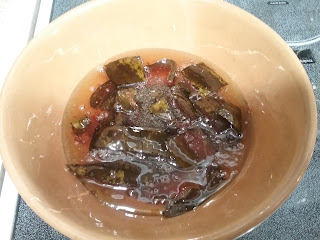The Challenge: In a jam. Make jam, jelly, or any sort of preserve.
The Recipe: Preserved watermelon rinds, from Miss Beecher's Domestic Receipt Book
Preserved Watermelon Rinds. This is a fine article to keep well without trouble for a long time. Peel the melon, and boil it in just enough water to cover it till it is soft, trying with a fork. (If you wish it green, put green vine leaves above and below each layer, and scatter powdered alum, less than half a teaspoonful to each pound.)
Allow a pound and a half of sugar to each pound of rind, and clarify it as directed previously. [Summary: Boil together 1 cup of water per pound of sugar, plus 1 egg white per 3 lbs sugar; skim as it boils, and again after cooling.]
Simmer the rinds two hours in this syrup, and flavor it with lemon peel grated and tied in a bag. Then put the melon in a tureen and boil the syrup till it looks thick, and pour it over. Next day, give the syrup another boiling, and put the juice of one lemon to each quart of syrup.
Take care not to make it bitter by too much of the peel. Citrons are preserved in the same manner. Both these keep through hot weather with very little care in sealing and keeping.
The Date/Year and Region: 1856, New York
How Did You Make It: I started by slicing up a watermelon, and setting aside 2 lb of the rind (in approximately 1"-2" wide pieces, though the directions don't specify). Being short a lemon, I set the pieces aside in water for 1 day, then boiled them until soft (~35 min). I did not use the vine leaves and alum for coloring.
[When I started this, I read 'peel' as 'remove the rind from the delicious red part'. About halfway through I realized it probably meant 'remove the hard green peel, leaving the white-green rind'. Although it never says specifically to cut the melon into the pieces or remove the inner flesh, I think the mention of layers strongly indicates that we're dealing with pieces of melon rather than a single whole melon, and that the term 'rind' indicates the red flesh shouldn't be used.]
While the rind was boiling, I separately boiled 3 lb of sugar in 3 cups of water with 1 egg white. As it boiled, I skimmed the liquid, then let it cool for 10 minutes and skimmed it again. Meanwhile, I juiced a lemon, cut the lemon peel into small strips, and put the peel into a small muslin bag. I then drained the watermelon, poured the sugar syrup over it, added the bag of lemon peel, and simmered it all a further 2 hours. I transferred the rinds and syrup to a ceramic bowl, and covered them loosely.
The next day, I removed as much syrup as I could from the bowl (maybe a bit over half of it--it was very thick, and much of it was sticking underneath the rinds, adhering them to the bowl and each other), and boiled it again for ~10 minutes. I then added 3/4 of the juice of 1 lemon to the syrup, poured it back over the rinds, and let it sit another day.
At that point, some of the syrup had started crystallizing (mostly along the top, where the reduced syrup was introduced), while elsewhere (especially down low) the syrup remained very viscous and sticky. The rinds themselves had darkened after the initial boiling, and seemed very well encased in sugar (taking on the gelatinous texture of candied citrus peel).
Time to Complete: Several days.
Total Cost: About $4 worth of sugar and lemon for 2 lbs of rinds (otherwise a waste product)
How Successful Was It?: Er... I need to research this one further. Since I love watermelon, and even a small melon apparently leaves 3-4 pounds of rind otherwise destined for the compost heap, I'll probably be tempted to try this recipe again. That being said, neither the taste nor the texture of the preserved rinds is really compelling me to try this again. Removing the green rind in advance will probably help with the texture issue (and the unappetizing appearance).
The texture, as previously mentioned, is sort of a solid gel (?), reminding me of candied lemon peel or ginger that hasn't dried out. However, the syrup around it has semi-hardened into a very thick, viscous material, more an amorphous solid than a liquid (like a soft taffy). The flavor wasn't quite watermelon or lemon, but definitely sweet.
Overall, this was a messy process that produced an odd food that I'm not sure if I like or what to do with. The recipe does reference to citron being preserved in the same way, which makes me wonder if preserved watermelon rind could substitute for preserved citron in some of my other receipts.
How Accurate Is It?: There's three ingredients, and the technique is basically 'boiling sugar in water' (which probably should have been my first warning....boiling sugar rarely works well for me). So, it's usual caveats about using an electric stove and modern varieties of fruit.
 |
| Pouring sugar syrup over the rinds. |
 |
| Preserved (basically candied) watermelon rinds. |

No comments:
Post a Comment
Thanks for commenting!